Architecture
Adobe bricks
 comments (0) comments (0) |
Bricks are made in an open frame, 25 cm (10 in) by 36 cm (14 in)being a reasonable size, but any convenient size is acceptable. Themixture is molded by the frame, and then the frame is removed quickly.After drying a few hours, the bricks are turned on edge to finishdrying. Slow drying in shade reduces cracking.
The same mixture to make bricks, without the straw, is used formortar and often for plaster on interior and exterior walls. Someancient cultures used lime-based cement for the plaster to protectagainst rain damage.
The brick’s thickness is preferred partially due to its thermal capabilities, and partially due to the stability of a thicker brick versus a more standard size brick. Depending on the form that themixture is pressed into, adobe can encompass nearly any shape or size,provided drying time is even and the mixture includes reinforcement for larger bricks. Reinforcement can include manure, straw, cement, rebaror wooden posts. Experience has shown that straw, cement, or manureadded to a standard adobe mixture can all produce a strong brick.]A general testing is done on the soil content first. To do so, a sample of the soil is mixed into a clear container with some water, creating an almost completely saturated liquid. After the jar is sealed thecontainer is shaken vigorously for at least one minute. It is then allowed to sit on a flat surface until the soil sediment has either collected on the bottom or remained a blended liquid. If the sediment collects on the bottom, that indicates there is a high clay content andis good for adobe. If the mixture remains a liquid, then there islittle clay in the soil and using it would yield weak bricks.
Thelargest structure ever made from adobe (bricks) was the Bam Citadel, which suffered serious damage (up to 80%) by an earthquake on December 26, 2003. Other large adobe structures are the Huaca del Sol in Peru, with 100 million signed bricks, the ciudellas of Chan Chan and Tambo Colorado, both in Peru.
adobe brick
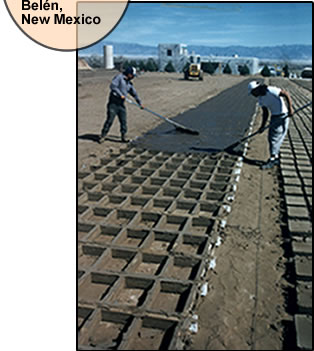
home near Santa Fe, NM
Mark Chalom, architect, made up of adobe brick
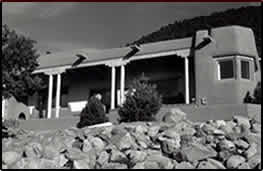
Adobe brick house under construction in Milyanfan village, Kyrgyzstan.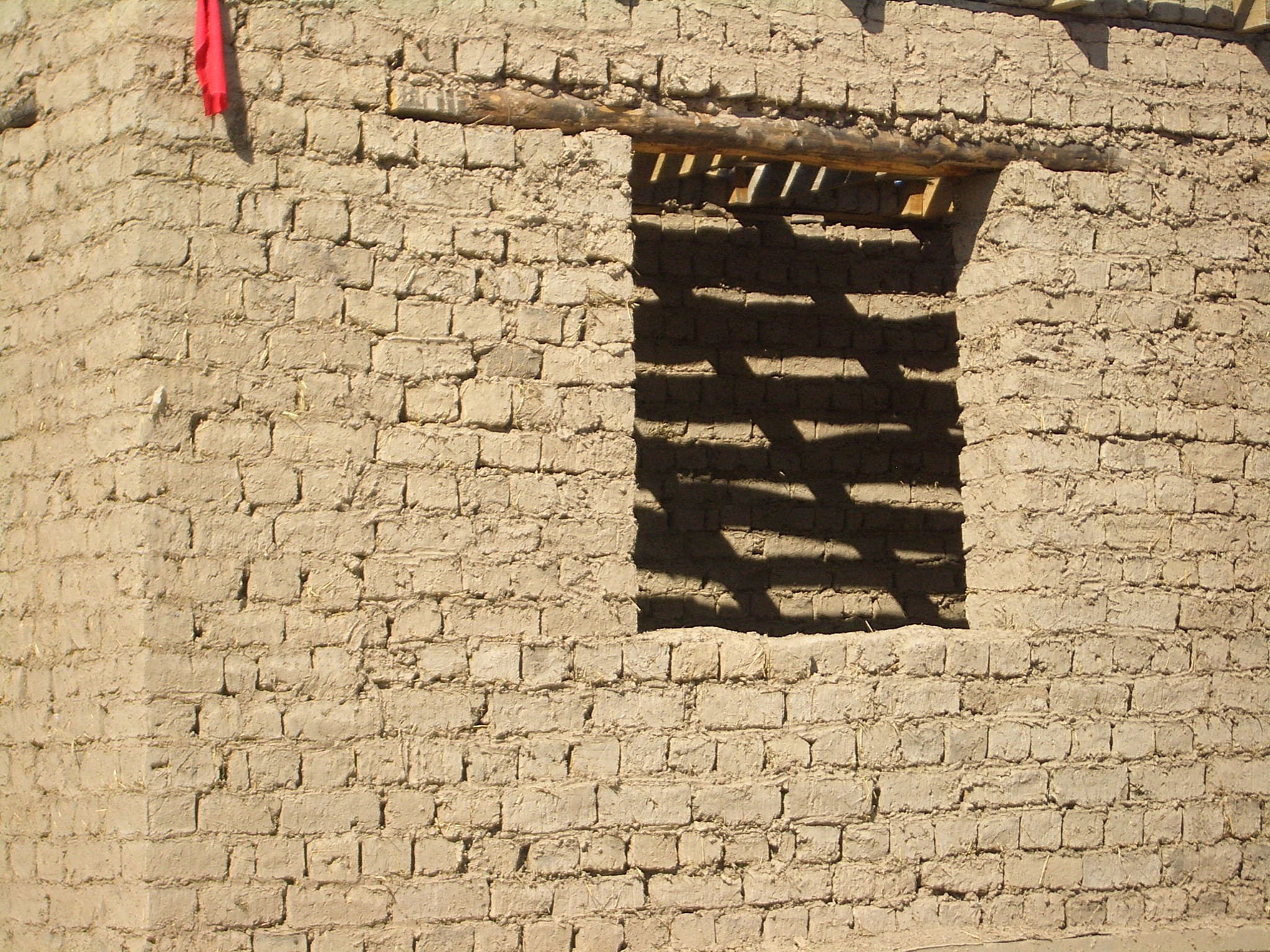
.Adobeis defined in the current International Building Codes, used across theUnited States. Individual states, such as New Mexico, Arizona andCalifornia, modify this code to fit their building practices. PressedBlock and Rammed Earth are generally included in these codes, which canalso be modified by individual counties and cities. Adobe was often a‘sleeper’ in previous codes, but with the new interest in greenbuilding, bureaucrats and legislators are eager to bring it forward andwork is underway to write it into ASTM standards.
Adobe Home Interior, Tucson, Arizona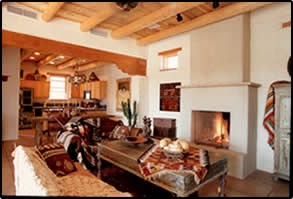
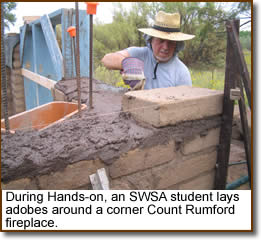
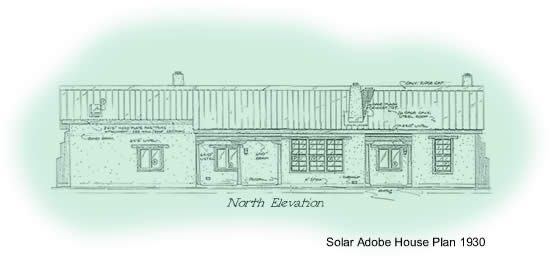
Solar Adobe House Plan 1930 Plan 1930 is a two-bedroom, two full-bath home with Santa Fe style features, but with a pitched metal 26-gauge roof for rainy/snowy locales. It is fitted with full passive solar glazing on its south side, consisting of both Direct Gain windows and Trombe walls. This south-solar array is about 330 sq. ft. of glass, or about 25% of the interior heated/cooled living space. A 25% ratio of south glass to interior living area would overheat in an Albuquerque or Prescott climate zone (5000'), but works well in the higher, colder areas of Northern Arizona, Northern New Mexico and Southern Colorado. At the same time, the additional south glass is needed to offset heat loss from some larger than usual north egress windows in the bedrooms, and especially the Diningroom. In these areas, the best energy saving technology the owner can afford should be used in the choice of windows. There are no windows on the west side of the home, and only two smaller windows in the Master Bath on the east side of the home. There are four insulated skylights, one over the Master Bed room walk-in closet, one over the Master Bath, one over the Wash/dry area, and one over Bath #2.
The Kitchen is partly open to the Living room over a half wall and rejas (ornate spindles).
Sliding glass doors separate the Kitchen from the Dining room on the north side. On the south side of the Kitchen, a secondary entry door provides handy access when groceries are coming in. Roughly 19 linear feet of upper cabinet space is shown in the Kitchen and with about 18 linear feet of two-foot wide counter space, not counting space for fridge, sink and stove.
Walls are 14" thick adobe with a few 10" thick adobe walls. In some code jurisdictions, or on certain sites, thicker adobe walls may be called for. Most plumbing walls are shown in 6" frame and most closet walls in 4" frame. The exterior "skin" for 1930 is a two-inch insulation layer, with ¾" stucco finish on the exterior. Interior adobe walls may be left exposed, or may be plastered. Insulation levels in the attic are shown as R44 in cellulose (recycled paper using Boron compounds which are fire and insect resistant).
Plan 1930 is drafted with three fireplaces, although any of those could be removed or replaced with a wood-burning stove. Back-up heating is via a zoned under floor radiant system and boiler. During many portions of the heating season, passive solar alone will provide sufficient energy, but as with all passive solar systems, the owners are obligated to operate night-time insulating curtains, to keep their daytime gain from radiating to the night sky. That is not too big a task with 1930, as the ten Trombe walls will require no curtains!
Room square footages are: Air Lock Entry 66.5 sq. ft., Dining room 112 sq.ft. (8x14'), Living room 289 sq.ft. (18x16'), Kitchen 144 sq. ft. (12x12'), Solarium 140 sq. ft. (40x 3.5'), Bath#2 70 sq. ft., Bedroom #2 144 sq. ft. (12x12' not counting closet), Master Bedroom 248 sq. ft. (14x14' and 8x6.5'), Master BR Closet 30 sq.ft. (6x5'), Master Bath 72 sq.ft. (12x6')
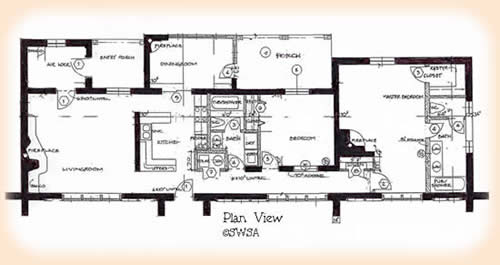
Storage: Besides the closet areas above, A roughly 2 x 5.5' linen closet is located just outside the Master Bed room door. An obvious long-term storage possibility is the attic, which provides roughly six feet of clearance at its peak (if a person were standing on the bottom truss chord at the center of the attic). Access hatches may be located as desired by the builder, but Plan 1930 shows one above the porch next to the Dining room (for exterior loading and unloading) and another above the Kitchen, where the hatch may be disguised by the exposed 1"x 8" deck at that point.
The two north portales or porches are 61 and 144 sq.ft. respectively. The larger porch has an entry to the Dining room, making it a spot for barbecues, a table and chairs on warmer summer days. The small Entry porch is well situated for firewood storage, although the Airlock room has plenty of extra space for firewood, as well as hats, coats, etc.
In the higher elevation areas where Plan 1930 is at home, the cooling load will be minor and an ordinary one-stage evaporative unit should be sufficient. Plan 1930 shows a corner position on the Dining room porch for a downdraft cooler that allows a simple ducting plan to be installed during the foundation work. A local heating and cooling service should determine proper CFM and duct sizes to fit local cooling loads before construction begins. The overhanging roof on the south side is calculated to shade the south wall during the summer months. Basically, overhangs are longer (shade more) in hotter climates and shorter (shade less) in colder ones. In high elevation zones above 6500', the south overhang should not extend more than 18" out (measured horizontally). Between 5000' and 6500' it should not extend out more than 24". These are approximate guidelines, and may be adjusted according to local microclimate. One method is to leave the 26 gauge metal roof projecting out the full 24", making sure that the roof framing is a foot back from the edge of the metal eave. After living in the house a year or two, the owner may decide if sun is needed earlier in the fall, and later into the spring. If so, the south eave may be trimmed back a few inches or more with a metal saw.
Plan 1930 comes as a set of seven, 24" x 36" sheets in black on white. The set contains Elevations (2 sheets), Floor Plan, Electrical Plan, Foundation Plan, Viga Framing Plan, Wall Sections (with fireplace section) and Radiant Heating Plan. Most scales are ¼"=1' 0", with some sections shown at ¾" = 1' 0" or 1"=1' 0
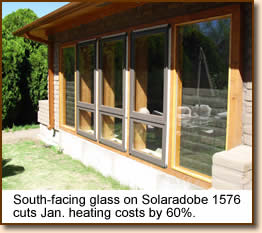
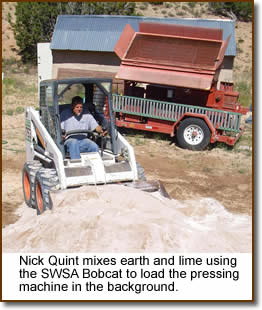
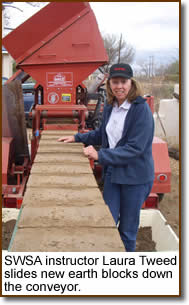
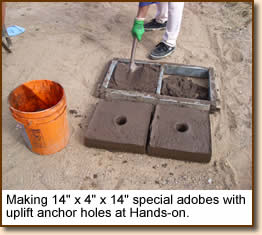
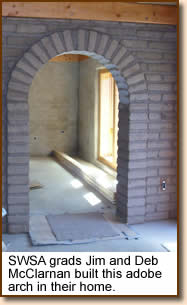
Earth-wallplastering and sealing expert Jim Estess explains an application toSWSA students. Jim's sealers have been used on large, commercial aswell as smaller scale earthen projects around the Western USA.
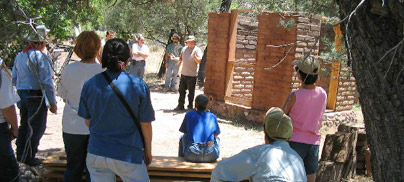
material magic in construction
 comments (0) comments (0) |
The world of construction without Building material is indefinite every one knows.......So iconic buildings are not by design iconic there is some material magic. so all construction field members will you all start reckoning the number of materials you know. At any instant it may come to a some little number. So here i am going to introduce the list of materials as far as i know..........just take an advantage of it.
List of materials as follows
1.Compressed earth block
2.Mud brick
3.rammed earth
4.Concrete
5.Composites
6.Rock
7.stones
8. Laterite stone
9. khandolite stone
10.granite
11. Marble
13. Tiles
14. glass
15. Mosaic
16. cement
17.Windows
a.Casement,
b.double hung,
c.bay window
d.Curtainwall,
e.skylight,
f.dormer
18.Wood, carpentry
a.Rough carpentry (unfinished)
I)Heavy timbers,
II)log home,
III)post and beam
b.Engineered wood, dimensional lumber
I)Stud,joist, rafter
II)Treated lumber & wood decking
c.Sheathing, subflooring, panelling
I)Plywood, shiplap, tongue and groove
II)Oriented strand board
d.Parallel strand lumber or "para-lam"

No comments:
Post a Comment